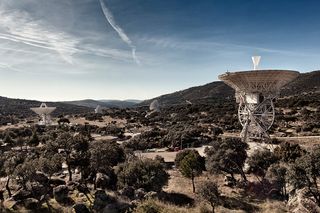What time will NASA's Perseverance rover land on Mars today?
A communications delay complicates the rover's landing time.

Update for 4 p.m. ET: NASA's Perseverance rover has successfully touched down on Mars! Read the full story here.
NASA's Perseverance Mars rover is scheduled to touch down on the Red Planet today (Feb. 18) at 3:55 p.m. EST (2055 GMT) — or at least that's when NASA will find out if it landed.
But by the time Earthlings hear from Perseverance for the first time since the landing attempt, the rover will have already spent at least 11 minutes hanging out on the surface of Mars. That's because it currently takes radio signals about 11 minutes, 22 seconds to travel between Earth and Mars, NASA said in a statement.
So, Perseverance's actual ETA, the time that it is supposed to land in Jezero Crater, is 3:44 p.m. EST (2044 GMT). But we won't know the exact time of landing — or whether the rover arrived intact — until 11 minutes, 22 seconds after the fact.
You can watch the Mars landing live here and on Space.com's homepage, courtesy of NASA, beginning at 2:15 p.m. EST (1915 GMT). The landing is expected at 3:55 p.m. EST (2055 GMT).
Related: How to watch NASA's Perseverance rover land on Mars
Live updates: NASA's Perseverance Mars rover mission
Book of Mars: $22.99 at Magazines Direct
Within 148 pages, explore the mysteries of Mars. With the latest generation of rovers, landers and orbiters heading to the Red Planet, we're discovering even more of this world's secrets than ever before. Find out about its landscape and formation, discover the truth about water on Mars and the search for life, and explore the possibility that the fourth rock from the sun may one day be our next home.
At the time of Perseverance's landing attempt, Mars will be about 127 million miles (205 million kilometers) from Earth, NASA said in a mission description. (The planet's distance from Earth changes as the two planets revolve around the sun in their respective orbits.)
Get the Space.com Newsletter
Breaking space news, the latest updates on rocket launches, skywatching events and more!
The radio signals that NASA uses to communicate with Perseverance and other missions travel at the speed of light, which is about 670,616,629 mph (1,079,252,848 kph). This cosmic speed limit means mission controllers at NASA's Jet Propulsion Laboratory (JPL) cannot instantaneously communicate with or operate the rover — or any other distant spacecraft, for that matter.

During the rover's landing, NASA's Mars Reconnaissance Orbiter (MRO) will act as a relay for lander radio communications. The orbiter will listen for messages from Perseverance and send information back to NASA's Deep Space Network of antennas on Earth.
Related: How a fleet of spacecraft will watch NASA's Perseverance rover land on Mars
Visit Space.com today for complete coverage of the Perseverance Mars rover's landing on the Red Planet.
Email Hanneke Weitering at hweitering@space.com or follow her @hannekescience. Follow us on Twitter @Spacedotcom and on Facebook.
Join our Space Forums to keep talking space on the latest missions, night sky and more! And if you have a news tip, correction or comment, let us know at: community@space.com.

Hanneke Weitering is a multimedia journalist in the Pacific Northwest reporting on the future of aviation at FutureFlight.aero and Aviation International News and was previously the Editor for Spaceflight and Astronomy news here at Space.com. As an editor with over 10 years of experience in science journalism she has previously written for Scholastic Classroom Magazines, MedPage Today and The Joint Institute for Computational Sciences at Oak Ridge National Laboratory. After studying physics at the University of Tennessee in her hometown of Knoxville, she earned her graduate degree in Science, Health and Environmental Reporting (SHERP) from New York University. Hanneke joined the Space.com team in 2016 as a staff writer and producer, covering topics including spaceflight and astronomy. She currently lives in Seattle, home of the Space Needle, with her cat and two snakes. In her spare time, Hanneke enjoys exploring the Rocky Mountains, basking in nature and looking for dark skies to gaze at the cosmos.

